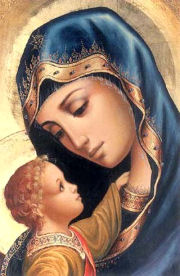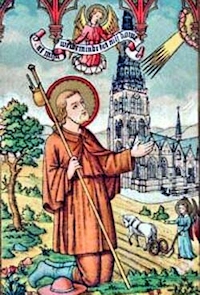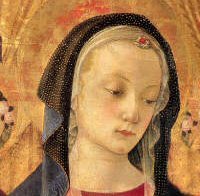Ordinary Time: September 12th
Optional Memorial of the Most Holy Name of the Blessed Virgin Mary
» Enjoy our Liturgical Seasons series of e-books!
Old Calendar: Most Holy Name of Mary; St. Guy of Anderlecht (Hist)
On this day dedicated to the Holy Name of Mary let us repeat that wonderful prayer of Saint Bernard, responding to Pope Benedict XVI's invitation to “invite everyone to become a trusting child before Mary, even as the Son of God did. Saint Bernard says, and we say with him: 'Look to the star of the sea, call upon Mary … in danger, in distress, in doubt, think of Mary, call upon Mary. May her name never be far from your lips, or far from your heart … If you follow her, you will not stray; if you pray to her, you will not despair; if you turn your thoughts to her, you will not err. If she holds you, you will not fall; if she protects you, you need not fear; if she is your guide, you will not tire; if she is gracious to you, you will surely reach your destination”' (Benedict XVI, address at Heiligenkreuz Abbey, September 9, 2007). — Luciano Alimandi
Most Holy Name of Mary In accordance with Jewish custom our Lady's parents named her eight days after her birth, and were inspired to call her Mary. The feast of the Holy Name of Mary therefore follows that of her Birthday, as the Feast of the Holy Name of Jesus follows Christmas. The feast originated in Spain and was approved by the Holy See in 1513; Innocent XI extended its observance to the whole Church in 1683 in thanksgiving to our Lady for the victory on September 12, 1683 by John Sobieski, king of Poland, over the Turks, who were besieging Vienna and threatening the West. This day was commemorated in Vienna by creating a new kind of pastry and shaping it in the form of the Turkish half-moon. It was eaten along with coffee which was part of the booty from the Turks.
In accordance with Jewish custom our Lady's parents named her eight days after her birth, and were inspired to call her Mary. The feast of the Holy Name of Mary therefore follows that of her Birthday, as the Feast of the Holy Name of Jesus follows Christmas. The feast originated in Spain and was approved by the Holy See in 1513; Innocent XI extended its observance to the whole Church in 1683 in thanksgiving to our Lady for the victory on September 12, 1683 by John Sobieski, king of Poland, over the Turks, who were besieging Vienna and threatening the West. This day was commemorated in Vienna by creating a new kind of pastry and shaping it in the form of the Turkish half-moon. It was eaten along with coffee which was part of the booty from the Turks.
The ancient Onomastica Sacra have preserved the meanings ascribed to Mary's name by the early Christian writers and perpetuated by the Greek Fathers. "Bitter Sea," "Myrrh of the Sea," "The Light Giver," "The Enlightened One," "Lady," "Seal of the Lord," and "Mother of the Lord" are the principal interpretations. These etymologies suppose that the Hebrew form of the name is Maryãm, not Miryãm. From the time of St. Jerome until the 16th century, preferred interpretations of Mary's name in the West were "Lady," "Bitter Sea," "The Light Giver," and especially "Star of the Sea." Stella Maris was by far the favored interpretation. The revival of Hebraic studies, which accompanied the Renaissance, led to a more critical appraisal of the meanings assigned to Our Lady's name. Miryãm has all the appearance of a genuine Hebrew name, and no solid reason has been discovered to warrant rejecting the Semitic origin of the word. The Hebrew name of Mary, Miryãm, (in Latin Domina) means lady or sovereign; this Mary is in virtue of her Son's sovereign authority as Lord of the World. We call Mary our Lady as we call Jesus our Lord, and when we pronounce her name we affirm her power, implore her aid and place ourselves under her protection.
Excerpted from Mariology, 3 volumes (1955-1961), edited by Juniper B. Carol, O.F.M.
Patron: People named Stella Maris, Estelle, Astrid, Astra, Muriel or Mary.
Symbols: Star of David, or six-pointed star appropriate for this feast.
Things to Do:
- Learn the hymn Ave Maris Stella.
- Pray the Divine Praises.
St. Guy of Anderlecht As a child Guy had two loves, the Church and the poor. The love of prayer growing more and more, he left his poor home at Brussels to seek greater poverty and closer union with God. He arrived at Laeken, near Brussels, and there showed such devotion before Our Lady's shrine that the priest besought him to stay and serve the Church. Thenceforth his great joy was to be always in the church, sweeping the floor and ceiling, polishing the altars, and cleansing the sacred vessels. By day he still found time and means to befriend the poor, so that his almsgiving became famous in all those parts.
As a child Guy had two loves, the Church and the poor. The love of prayer growing more and more, he left his poor home at Brussels to seek greater poverty and closer union with God. He arrived at Laeken, near Brussels, and there showed such devotion before Our Lady's shrine that the priest besought him to stay and serve the Church. Thenceforth his great joy was to be always in the church, sweeping the floor and ceiling, polishing the altars, and cleansing the sacred vessels. By day he still found time and means to befriend the poor, so that his almsgiving became famous in all those parts.
A merchant of Brussels, hearing of the generosity of this poor sacristan, came to Laeken, and offered him a share in his business. Guy could not bear to leave the church; but the offer seemed providential, and he at last closed with it. Their ship, however, was lost on the first voyage, and on returning to Laeken Guy found his place filled. The rest of his life was one long penance for his inconstancy. About the year 1012, finding his end at hand, he returned to Anderlecht, in his own country.
As he died, a light shone round him, and a voice was heard proclaiming his eternal reward.
Excerpted from Lives of the Saints, by Alban Butler, Benziger Bros. ed. [1894]
